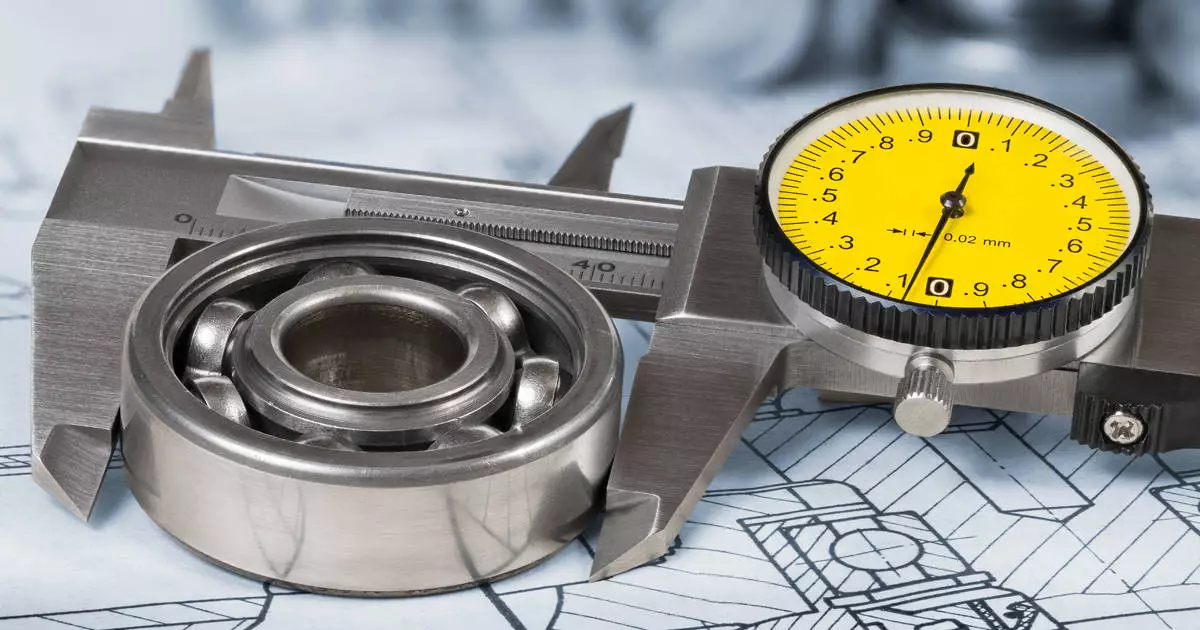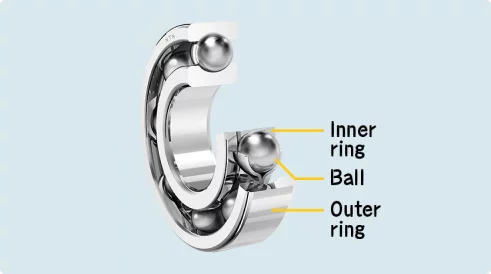
Bearing Basics
In this article, I will profile the SKF product while discussing the basic bearing knowledge you will need to navigate around the interesting world of bearings.
The role of a bearing is to make friction close to zero, which allows the rotation to run smoothly. Friction is the force that prevents things from moving. For example, for automotive tires to rotate smoothly, the friction should be as little as possible.
Rolling Bearings are comprised of inner and outer rings, a rolling element, a ball, or a roller usually with or without a retainer. Bearings have many other specifications for internal clearance, raceway curvature, enclosures, and lubrication to mention a few.
Bearings whether rolling ball or roller are intended to support and guide using the least amount of friction while rotating or oscillating as elements in machine operation. Bearings are used to transfer loads between machine components providing high precision, low friction and the least amount of noise emissions. SKF Bearings provide a very cost effective means by which to transfer loads, while supporting machine components and conform to ISO standards.
The two standard types of rolling elements are ball and rollers.
The two basic types of rolling elements are the determinate as to what the bearing function is. Ball bearing uses balls, roller bearings use rollers. Ball and rollers make contact differently with the raceways.
- Ball → ball bearing
- Roller → roller bearing

As the load increases acting on the bearing, the contact point forms into an elliptical area. This small point of contact allows for lower rolling friction. Because of the small contact point, SKF ball bearings can easily accommodate higher speeds as well. Conversely, SKF ball bearings will have limits for load-carrying capacity versus SKF roller bearings.

When there are higher loads acting on the roller bearing, the contact line will become rectangular in shape. In SKF roller bearings with a larger contact area along the line they are able to carry heavier loads. As with the greater surface area the roller is generally operating at lower speeds than ball bearings of similar size.
SKF Radial and Thrust bearings
SKF rolling bearings can be classified based on the direction of the applied loads they are needed to accommodate. For example SKF radial ball bearings are used when loads act primarily perpendicular to the shaft. Some radial bearings support pure radial loads only, most however can additionally accommodate some axial loads in one direction and, in some cases, both directions. In the below (fig. 3). You see a roller bearing designed for axial load or loads parallel to the shaft and then a radial ball bearing used to accommodate radial loads or loads perpendicular to the shaft.

Thrust bearings
SKF thrust ball bearings accommodate loads that act predominantly along the axis of the shaft or parallel to the shaft. Various types of SKF thrust bearings will support pure axial loads in one or both directions (fig. 4)

Other SKF thrust bearings can accommodate radial loads (combined loads, fig. 5).

Thrust bearings cannot accommodate speeds as high as similar sized radial bearings.
Symbols used by SKF and the rest of the bearing industry are in accordance with ISO standards. The most common symbols are:
- d Bore diameter
- D Outside diameter
- B Bearing width
- H Bearing height
- r Chamfer dimension
- α Contact angle
SKF Bearing manufactures several bearing types enclosed with seals or shields on one or both sides. SKF Bearings enclosed on both sides are factory-filled with grease. Sealed ball bearings provide an economic, space-saving solution compared to other added machine component seals.
Bearing rings
Bearing outer and inner rings will fatigue over time and that is why SKF and most manufacturers use 52100 or equivalent hard chromium steel in manufacturing the rings.
The SKF bearings standard steel for bearing rings and washers is 100Cr6, a steel containing approximately 1% carbon and 1,5% chromium.
Depending on specific requirements, SKF will use a 440C stainless steel or equivalent, high-temperature steels and special corrosive resistant materials like cronidur and ceramics.
SKF rolling elements (balls or rollers) used to transfer the load between inner and outer rings are made from these various steels depending upon the application. Normally, the same steel is used for rolling elements as for bearing rings and washers. In many instances rolling elements will be made of ceramic. SKF Bearings with ceramic rolling elements are referred to as hybrid bearings and are becoming widely used .
The primary purposes of a cage are: cages, retainers and separators are all the same word for describing that which separates the rolling elements. The spaces created by cages reduce the frictional heat generated in the rolling bearing.
Cages serve to keep rolling elements evenly spaced to optimize load distribution.
Guiding the rolling elements in the unloaded zone of the bearing.
There are a number of cages offered by SKF and other manufacturers and I have listed them below.
Cage Types
- Stamped metal cages;
- Stamped metal cages (sheet steel or sheet brass) are lightweight and withstand high temperatures;
- Machined metal cages;
- Machined metal cages are brass or steel or light alloy. They permit high speeds, temperatures, accelerations and vibrations;
- Polymer cages. Polymer cages are made of polyamide 66 (PA66), polyamide 46 (PA46) or sometimes polyetheretherketone (PEEK). The sliding properties of polymer cages create little friction and are good for high speeds;
- Pin-type cages;
- Steel pin-type cages require pierced rollers and are used with large-sized roller bearings. These cages have relatively low weight and enable a large number of rollers to be incorporated.
Seals and Shields
Seals can significantly prolong bearing service life because seals can keep lubricant in the bearing and contaminants out of it. SKF bearings are available with numerous seal types.
Shields
For steel shields there is a small gap between the shield and inner ring. Shielded bearings are used where the operating conditions are in a cleaner environment and where lower friction is acceptable.
Seals
Bearings with seals are specified so as to contain lubricant and prevent the ingress of contaminants full contact seals are effective when water or moisture has a chance of entering the bearing. These seals make positive contact with the sliding surface on one of the bearing rings. Low-friction seals and non-contact seals are used to equate to the same speeds as bearings with shields, but with improved sealing effectiveness.
Basic Designations
A basic designation will contain three to five digits.
The first digit or letter or combination of letters identifies the bearing type.
The next two digits identify the ISO dimension series.
The last two digits of the basic designation are the bearing bore and when multiplied by 5 gives the bore diameter (d) in mm. This calculation is true for all bearings except those with a bore diameter of 10, 12, 15 or 17 mm which have the following size code identifications:
- 00 = 10 mm
- 01 = 12 mm
- 02 = 15 mm
- 03 = 17 mm
For example a 6200 bearing has a 10mm bore, a 6201 bearing has a 12mm bore, a 6202 bearing has 15mm bore and a 6203 bearing has a 17 mm bore. All higher numbers such as 6204 has a (04×5) 20mm bore and 6205 has a (05×5) 25 mm bore and so on through the entire bearing series.
For bearings with a bore diameter < 10 mm, or ≥ 500 mm, the bore diameter is generally given in millimeters. The size identification is separated from the rest of the bearing designation by an oblique stroke, e.g. 618/8 (d = 8 mm) or 511/530 (d = 530 mm). This is also true for standard bearings in accordance with ISO 15 that have a bore diameter of 22, 28 or 32 mm, e.g. 62/22 (d = 22 mm).
For some bearings with a bore diameter < 10 mm, like deep groove, self-aligning or angular contact ball bearings, the bore diameter is only given in millimeters and not separated by an oblique stroke, e.g. 629 or 129 (d = 9 mm).
Bore diameters that deviate from the standard bore diameter of a bearing are shown in millimeters up to three decimal places. This bore diameter identification is part of the basic designation and is separated from the basic designation by an oblique stroke, e.g. 6202/15.875 (d = 15,875 mm = 5/8 in). This is often found for standard metric bearings with special bores which may be in either inch and metric dimensions.
This article serves to introduce you to bearing basics. For further information please contact us a [email protected].
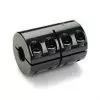
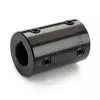
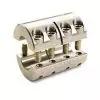
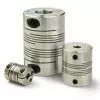
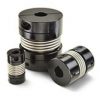
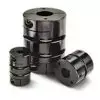
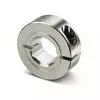
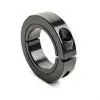
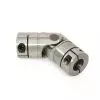
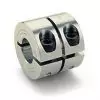 Short Rigid Couplings
Short Rigid Couplings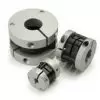 Controlflex Couplings
Controlflex Couplings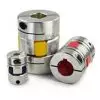 Jaw Couplings
Jaw Couplings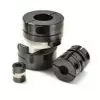 Oldham Couplings
Oldham Couplings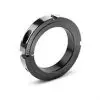 Bearing Locknuts – TCN
Bearing Locknuts – TCN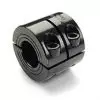 Double Wide Shaft Collars
Double Wide Shaft Collars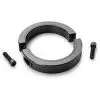 Heavy Duty Shaft Collars
Heavy Duty Shaft Collars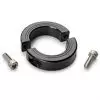 International Series Shaft Collars
International Series Shaft Collars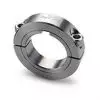 Keyed Shaft Collars
Keyed Shaft Collars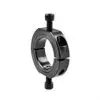 Mountable Shaft Collars
Mountable Shaft Collars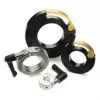 Quick Clamping Shaft Collars
Quick Clamping Shaft Collars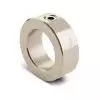 Set Screw Shaft Collars
Set Screw Shaft Collars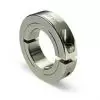 Thin Line Shaft Collars
Thin Line Shaft Collars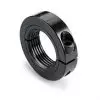 Threaded Shaft Collars – Pacific International Bearing Products
Threaded Shaft Collars – Pacific International Bearing Products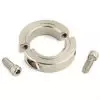 Two-Piece Shaft Collars
Two-Piece Shaft Collars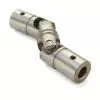 Friction Bearing Universal Joints
Friction Bearing Universal Joints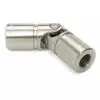 Needle Bearing Universal Joints
Needle Bearing Universal Joints
